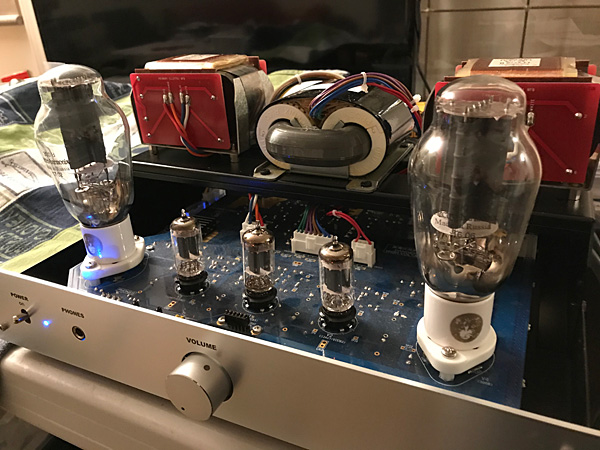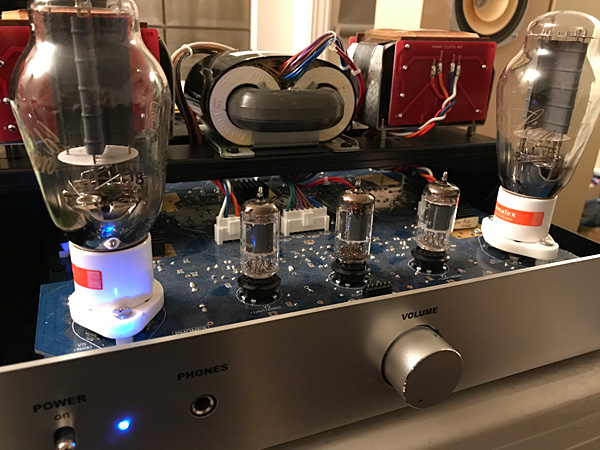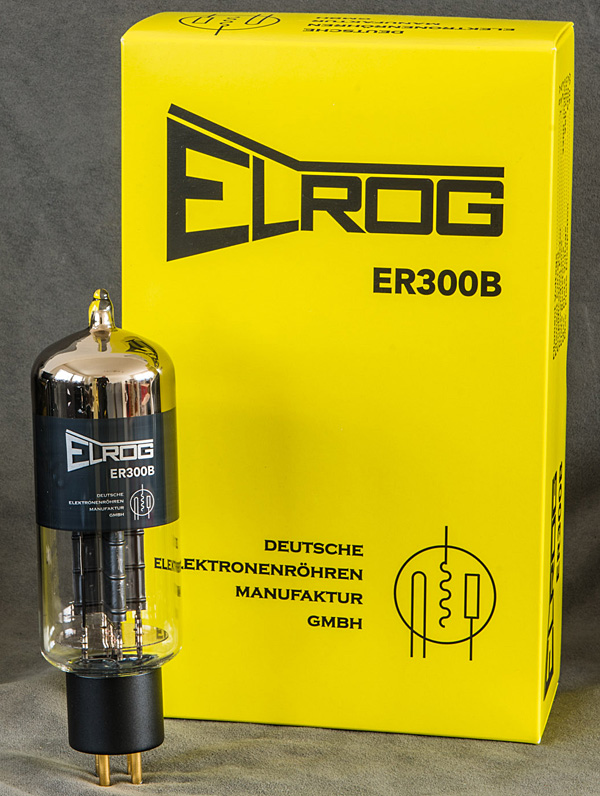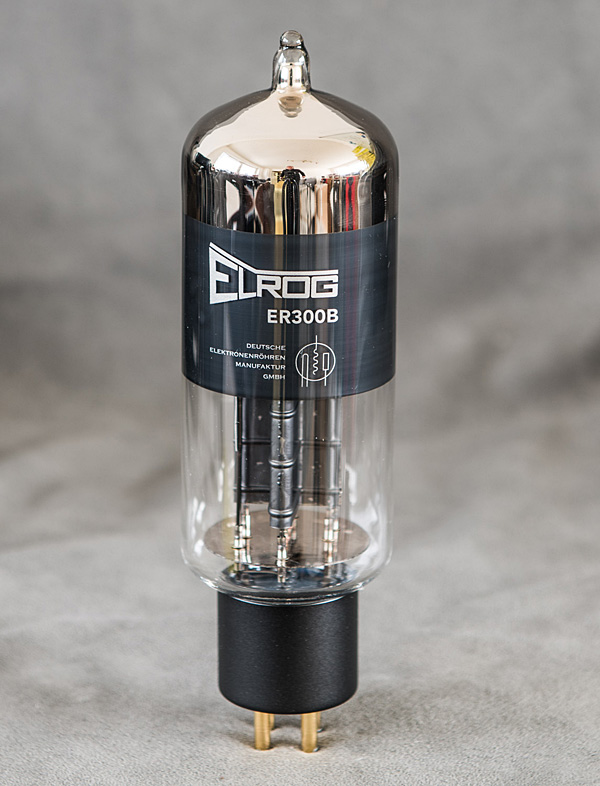| Columns Retired Columns & Blogs |
Don't get filthy now...
If they build it, I will come.
At least the TU-8600R's case and chassis are old-school. It measures 15.2" wide by 8.5" high by 12.8" deep and weighs 28.2 lb. Its black, crinkle-paint transformer cover and tube cage are definitely old-school. On the brushed-aluminum faceplate is a on/off toggle switch with a little blue On light, a ¼" jack that connects the plug of a pair of headphones directly to the secondary of the output transformer, and a large knob for that Alps volume pot. Nothing else.
On the rear panel are a single pair of RCA line-level inputs and two pairs of three-way speaker binding posts, one per channel, plus a switch that matches the transformer secondary to speakers of impedances of 4–6 or 8–16 ohms. All very nice, but . . .
What about the tubes?
Tubes
The $1785 price of the TU-8600R kit does not include tubes. VK Music offers two different tube sets, both Russian-made. The first, all Electro-Harmonix tubes, costs $265 and includes matched pairs of EH Gold 300Bs and EH Gold ECC82/12AU7s, and a single EH Gold ECC83/12AX7. The second set costs $400, and includes a matched pair of Genalex Gold Lion PX300Bs, two gold-pinned Gold Lion ECC82/12AU7s, and a single gold-pinned Gold Lion ECC83/12AX7.
I listened to the TU-8600R with both tube sets. Both produced clean, undistorted, irreproachable sound, and both sets were dead quiet—as was the TU-8600R amplifier. Which tubes did I prefer? I liked them both the same.
Electro-Harmonix Gold tubes
Mike Matthews's New Sensor Corp. is based in Long Island City, New York. His ExpoPul-Reflektor factory, in Saratov, Russia, manufactures vacuum tubes under the brand names Electro-Harmonix, Genalex, Mullard, Sovtek, Svetlana, and Tung-Sol (footnote 2). Tubes from this factory are rugged and reliable, and sound clear and quiet—but nowhere near as seductive as some highly sought NOS tubes from American or European manufacturers.

The reliability and distinctive sound of Electro-Harmonix's EH 300B might stem from the fact that Matthews specifies only a "double carbonate" (calcium and barium) emissive layer on its cathode. Omitting a third layer (strontium) makes the cathode less emissive, but makes this tube model measure more consistently from sample to sample. Leaving out the strontium may also let the tube's sound character remain at a more even level throughout the tube's working life.
And if memory serves me, Western Electric's psychedelic 300A tube differed from WE's more analytical-sounding 300B in one crucial way: Like the EH 300B, the 300A's emitter had a double-carbonate cathode. When they added a layer of strontium, they changed the designation to 300B.
Genalex Gold Lion tubes
Some claim that the Genalex Gold Lion PX300B is an enhanced, further ruggedized version of the Electro-Harmonix PX300B, which it resembles physically and sonically. Unfortunately, I can't verify that. But to my ears, both Russian-made 300Bs have the same tight bass and water-clarity of their WE 300A forebear, though not the WE's color-saturated midrange or relaxed high frequencies.

Elrog 300B tubes
VK Music also offers a special TU-8600R package ($2985) that includes premium German-made Elrog 300B tubes in place of the Genalex Gold Lions.

Elrog Elektronenröhren GmbH Co. KG went bankrupt in 2015. Fortunately, my smart amp-builder friend, Thomas Mayer, founded Deutsche Elektronenröhren Manufaktur GmbH and bought Elrog's brand name, as well as all of Elrog's remaining machinery, materials, and intellectual properties. His goal was to make the best-sounding, most durable directly heated triode tubes possible.
Mayer proceeded to overhaul all of Elrog's machines, improve quality control, and upgrade the quality of raw materials—especially the tungsten wire for the tubes' filaments, which now contains a higher proportion of thorium.
Every other tube in this survey has what's called a dull emitter, which uses an oxide-coated filament that heats up to about 1000°F and produces a warm, orange, fireplace-like glow. But the Elrog 300B's thoriated tungsten filament heats up to around 2500°F and emits a brilliant white light, hence the term bright emitter. Electrically, the Elrog 300B is a drop-in replacement for any amplifier designed to run on 300Bs—but its uniquely shaped glass envelope is too tall for the EleKit's tube cage.

Compared to the Russian 300Bs, the Elrogs produced a more volatile, ether-like transparency that reached more elegantly into the upper octaves, while generating a luminous harmonic spectrum unmatched by any of the dull emitters: scintillating yet understated. My personal favorite.
EleKit TU-8600R vs First Watt SIT-3
When the EleKit TU-8600R arrived, I was excited to try it right away but was still in the clutches of an ecstasy triggered by the First Watt SIT-3 solid-state power amp and the DeVore Fidelity Orangutan O/93 speakers. I was thinking it might be the best amp-speaker combo I'd heard since I was in diapers. However! When I swapped out the no-feedback SIT-3 for the TU-8600R with its feedback, I found myself reluctant to admit the obvious: The TU-8600R seemed more clearly spoken, more transparent, and, yes . . . breathy. What killed me was how the bass seemed stronger and tighter. I was flummoxed.
EleKit TU-8600R vs Line Magnetic LM-518 IA
Everyone knows I love the Line Magnetic LM-518 IA for how it pumps out spirited, transparent energy. It makes sopranos sound true of tone and forcefully poetic. Its 845 triode tubes give vivid light and natural life to every kind of music.
But when I removed the TU-8600R and connected the Line Magnetic to its all-time favorite speakers, DeVore's Orangutan O/93s, the LM-518 IA sounded clamorous and adolescent, less refined than I remembered. Naturally, its 845 tubes had their signature strut and iridescent highs—but the EleKit's 300Bs were clearly clearer, quieter, more transcendent.
EleKit TU-8600R with KEF LS50 loudspeakers
Not surprisingly, the Line Magnetic LM-518 IA outperformed the TU-8600R with KEF's LS50s. The single-ended 845s delivered more vigorous, more engaging sound, and pumped the woofers harder. Into the LS50s, the TU-8600R made music seem slower, darker, slightly reticent. Nevertheless, the EleKit's 300Bs did a perfectly clear and beautiful job of presenting Joni Mitchell "having fun," "being strong," and wrecking her stockings in that "jukebox dive" in "All I Want," from Blue (24/96 FLAC, Reprise/Tidal). The EleKit made the KEFs sound nice, but not special or live.
EleKit TU-8600R with Abyss AB-1266 and Audeze LCD-X headphones
With the EleKit's volume control all the way open (inputs not shorted) and with no music playing, I heard only silence through Audeze's sensitive (103dB/1mW) LCD-X headphones. That's quiet.
I wish you could have heard Wagner's Die Walküre—with Birgit Nilsson, Hans Hotter, and Christa Ludwig singing, Georg Solti conducting the Vienna Philharmonic, and John Culshaw producing (5 LPs, London OSA 1509)—through my Abyss AB-1266 Phi headphones connected to the output of EleKit's TU-8600R SET 300B amplifier. The depth of space and accuracy of tone exceeded anything I could imagine hearing from loudspeakers. Inner detail? Information recovery felt like 100%. Tiny sounds really mattered. I heard no subtractive distortions. I wasn't looking at a puppet-theater opera between my speakers—I was there in Vienna's Sofiensaal in 1965, with all those bigger-than-life performers.
The TU-8600R's headphone output was the best I've heard from an integrated amplifier. In fact, if the EleKit TU-8600R were only a headphone amp, it would still be a great value for the money.
EleKit TU-8600R with Zu Audio Soul Supreme loudspeakers
Error correction and signal modification, whether in the form of negative feedback, degeneration, DSP, or some tangled mess of filters in a DAC or loudspeaker crossover, obfuscates the raw signal in myriad ways. I believe these obfuscations distance listeners from the essence of the recording. Zu Audio's Soul Supreme ($4400/pair) is the only loudspeaker I have in which the voice-coil of a drive-unit is directly connected to the output terminals of the amplifier, with no intervening crossover. Which means that, with the right amplifier, the Soul Supreme's 10.3" full-range paper cone can dance extremely well. Not surprisingly, the EleKit TU-8600R sounded like a right amplifier.
I used the EleKit's 8–16-ohm output tap with the 16-ohm Zus. This gave music a compellingly relaxed, almost glamorous-sounding presentation that was extremely effective at making me forget everything but the music. Say amen, people.
EleKit TU-8600R with Klipsch RP-600M loudspeakers
As much as I cherish the supreme musical pleasures generated by the DeVore Orangutan O/93s ($8400/pair) driven by the First Watt SIT-3 ($4000), I was overwhelmed by how precise and electrifyingly beautiful the EleKit TU-8600R sounded driving Klipsch's RP-600M loudspeakers ($549/pair), which are reviewed elsewhere in this issue. I would never have predicted this (footnote 3).
The combo of DeVores and First Watt costs $12,800, plus cables. The EleKit and Klipsch RP-600Ms together cost only $2600, but musically and sonically satisfied me as much as if they cost $26,000. To my complete surprise, this pairing exceeded the Orangutan+SIT-3 combo in apparent speed, tightness of bass, and boogie PRaT fun factor. The TU-8600R powering the RP-600Ms, sourced by the Chord Qutest DAC ($1895), created a complete under-$6k system, including cables and stands, that I'd be hard-pressed to improve on.
This is what I call value for money.
Conclusions
The EleKit TU-8600R may look like a generic, old-school, single-ended 300B integrated amplifier, but its sonic character is clean, neutral, and precise in a distinctly 21st-century way. It doesn't sound at all warm or soft, but fast and vigorous, as transparent as any amplifier, and extremely captivating. My many months of auditioning it suggest that, with the right speakers, this humble amp kit could please discriminating listeners as much as any amplifier at any price. Bravo, Yoshitsugu Fujita. Thank you, Victor Kung.
Footnote 3: As you can see from the measurements accompanying the review, while the Klipsch RP-600M is only a couple of dB more sensitive than average, its impedance rises from 3.5 ohms in the lower midrange to an average of 16 ohms in the treble. With an amplifier with a high source impedance, like the EleKit, this will boost the high frequencies.—John Atkinson

Don't get filthy now...
If they build it, I will come.

"Build Me Up Buttercup" ........... The Foundations :-) .........

Its very nice we have you in Stereophile Herb. Thanks for such an elaborative review.

... remaining at chez Reichert long enough for Herb to acquire and evaluate samples of the EAT 300B and new production Western Electric 300B tubes?
https://www.europeanaudioteam.com/en/e.a.t.-300b-valve-wp000024.html
https://www.westernelectric.com/products/300b.html

I 'd like to humbly suggest a fresh 300B tube shootout- especially if the new production WE 300B ever debuts. Thorsten's classic is by now outdated (it served us well for a long time). How about it, Mr. Reichert?! Also, once and for all: are EH Gold Pins the same exact tube as Gold Lion PX300B's? You seemed to miss a perfect opportunity to tell us. Thanks for a great review.

Check out Stereophile article ..... 'In search of the perfect 300B tube' by PVW :-) ...........

How often do you see tube rectifiers driving the output of modern tube or solid state amplifiers?....power conditioners? Power Conditioner? It's getting too silly. End of subscription.

And I wonder Herb if one day you also give EAR 869 a chance for review. To me its one of the most heavenly sounded SET amp, any amp, ever made by human being! Especially it sounds wonderfully with my Wilson Sasha2 although it is just shy of 15 watts. Regards.

I'll bet they are. Any takers ?
The Highest HighEnd Audio Systems seem to have tubes "Singing" seductively.
All things considered, the Schiit Valhalla 2, loaded up with carefully selected Russian Tubes, was the finest Singing Amplifier I've ever heard. ( I've heard & owned plenty of Amps )
Having said all that, I come to prefer & rely-on the "Stable" Performance of a Class A Solid-State Amplifier or even a nice AB Solid-State Amplifier with a well-Rolled Tube Amplification as Back-up/ Show-off Gear.
Tube Gear is variable in Singing Voice & way too variable in useful life cycle and getting "Pricy" unless they are the best dam tubes EVAH and the Quarterly Bonus was bigger than expected.
Still, the "right" tubes can give the cute little Schiit Valhalla 2 a Luciano Pavarotti Singing Voice. ( it even has a Pre-Amp output ) Price: $350ish.
Tube Gear and Tube Rolling is an exciting social Hobby in itself and if there is a leading Authority it would be Mr.HR with guys like Kevin Deal finding supplying the fresh "juice" .
God Bless the Tube Only People who seem to be inspiring manufacturers to Build greatness. ( like Psvane )
6SN7s & EL34s make the World a better place!
Tony in Michigan
ps. Can we have another review Category: Vacuum Tube Reviews ?, such as the Psvane ACME Supreme series 300B pair MSRP $1,075.00 USD

Mr.HR seems to have the flowing ability to describe some of the most nuanced variations of sound qualities. Hmm
I wonder:
Can/Could one of those PS Audio Power Plant devices deliver a reliable Foundational Base for our Mr.HR to ply his Reviewing Craft?
Would it increase the accuracy of all those liquid adjectives ?
Would it minimize the Neurotic/Psychotic tendencies of Audio Gear's perceived performance.
We should expect Greatness from our "Senior Editors", shouldn't we, especially if he's HighEnd Audio's Poet Laureate.
Tony in Michigan
ps. might as well suggest that Steve G. should also have a PS Power Plant, dammit !

...My sample was assembled by the distributor using WBT silver solder. (I recommend tin-lead solder, which melts at a lower temperature than silver, and reduces the likelihood of cold-solder joints.)" quoted Herb Reichert.
No lead solder please for health's sake.
I've been using lead-free SILVER solder wires for many many years. Mine is always MG Chemicals RoHS approved lead-free silver wires, cheap & low melting & healthy !!!!!
For audio signal paths soldering, I ALWAYS use silver solders, period. NO cold joints at all!
For grounding or non-signal path circuits, I may use lead/tin solder wire.
Listening is believing
Jack L
Canada

I noticed you removed your worthy and informed response to my whinge regarding valve recs and power conditioners and other assorted grumblings. It appeared in my inbox. Oh and thanks for the heads up regarding MG Chems Silver solder. I'll check that out.
I take well to criticism. I ignore nonsense. The dishonest have there own war.
Jason Jackson
Sydney AU


And again dear Herb, If you try to get your Qutest an external USB battery pack instead of using its own external PS, you will be probably rewarded with even more vibration all over your body rather than just your ear drums when you listening to a cello suite! Cheers.

I've always wanted to try a 300B SET amp. Herb, your review provoked me to order the upgraded kit specced like yours and with the Gold Lion 300Bs. I have built many kits over the years. This was the best packed, picked, instructed kit I have ever seen. The build was fun. I would only suggest that folks without much soldering experience practice first as the PCB is densely populated in some places and some solder pads can be really close to one another.
When the time came for lift-off, I had the usual jitters. Viola, tubes glowed and the amp's sound floor was extraordinary. Even without break-in, driving my DeVore Gibbon 3XLs, they never sounded better. They sang in the most musical fashion. From the lowest notes to the highest, it was a whole new experience.
Thank you Herb!!!!!!!!!

Herb, I bought both the Abyss 1266 Phi TC and Elekit TU-8600R after reading your review. You said "through my Abyss AB-1266 Phi headphones connected to the output of EleKit's TU-8600R SET 300B amplifier. The depth of space and accuracy of tone exceeded anything I could imagine hearing from loudspeakers."
When I connect the Abyss to the front headphone jack on Elekit, with all the jumper settings, there is not enough power and I can hear distortion from clipping even at low-moderate volume levels. When I directly connect the Abyss to the actual speaker binding posts, there is more than enough power and never clipping. Did you drive the Abyss fine from the front headphone jack somehow or are you talking about connecting the Abyss to the speaker binding posts? Thank you.

thank you for reading my stuff. For the Elekit review, I connected the Abyss to both - front and back. But my finings matched yours. I mainly connect the AB-1266 Phi and the HiFiMan Susvara and HE6se - to the output terminals of power amplifiers.
hr

Hi Herb, this one is old news but perhaps this comment will find you...
Did you pair this amplifier with your ls3/5a's by chance, and if so how did you find that match?
Best regards.